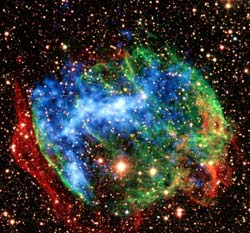This area deals with the fundamental laws and building blocks of nature and how they interact, the properties and the behavior of matter, and research into space and time and their structures.
innovations-report provides in-depth reports and articles on subjects such as astrophysics, laser technologies, nuclear, quantum, particle and solid-state physics, nanotechnologies, planetary research and findings (Mars, Venus) and developments related to the Hubble Telescope.

The implementation of European Space Policy is moving forward this week as experts from Member States and international organisations meet to flesh out the main lines of a European Space Programme. Experts are meeting today to assess the EU’s space and security capabilities and future needs. Discussions on the security dimension of Space Policy address satellite border control, conflict prevention, humanitarian missions, and fighting organised crime and terrorism. On 4 June, Member State experts g

On June 8 Earth-based solar telescopes will follow a tiny black orb as it appears to travel effortlessly across a wrinkled, brilliant sea. Timothy Brown, a scientist at the National Center for Atmospheric Research (NCAR), will not sit idly by as Venus traverses the Sun for the first time in 122 years at an angle visible from Earth. Peering through a specialized solar telescope in the Canary Islands, Brown will study the chemical composition and winds of Venus’s upper atmosphere, a region poorly ob

Satellite pins down distance to important exploded star
The Veil Nebula, a delicate network of glowing gaseous filaments in the northern constellation of Cygnus the Swan, has long been a favorite of both amateur and professional astronomers. Part of a much larger nebula known as the Cygnus Loop, the Veil is comprised of the leftovers of a star that exploded between 5,000 and 8,000 years ago.
For at least half a century, scientists have probed the Cygnus Loop with various tec

Combined data from NASA’s Chandra X-ray Observatory and infrared observations with the Palomar 200-inch telescope have uncovered evidence that a gamma-ray burst, one of nature’s most catastrophic explosions, occurred in our Galaxy a few thousand years ago. The supernova remnant, W49B, may also be the first remnant of a gamma-ray burst discovered in the Milky Way.
W49B is a barrel-shaped nebula located about 35,000 light years from Earth. The new data reveal bright infrared rings,

Twenty years ago, astronomers discovered a number of enigmatic radio-emitting filaments concentrated near the center of the Milky Way Galaxy. These features initially defied explanation, but a new study of radio images of the Galactic center may point to their possible source.
By combining data from the National Science Foundation’s Very Large Array (VLA) and Robert C. Byrd Green Bank Telescope (GBT), astronomer Farhad Yusef-Zadeh of Northwestern University has found evidence that at least

Researchers at the University of Colorado at Boulder have solved a major galactic mystery that may help astronomers in their quest to develop a detailed picture of the chemical evolution of the Milky Way galaxy.
Speaking at the 204th meeting of the American Astronomical Society held May 30 – June 3 in Denver, the researchers reported that the abundance of deuterium, a heavy form of hydrogen, in the Milky Way galaxy today shows a consistent pattern that can be simply explained, lifting a vei